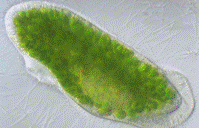Biological Sciences, School of

School of Biological Sciences: Faculty Publications
Document Type
Article
Date of this Version
2000
Abstract
To quantify the adaptive significance of insect learning, we documented the behavior and growth rate of grasshoppers (Schistocerca americana) in an environment containing two artificial food types, one providing a balanced diet of protein and carbohydrate, which maximizes growth, and the other being carbohydratedeficient, which is unsuitable for growth. Grasshoppers in the Learning treatment experienced a predictable environment, where the spatial location, taste, and color of each food source remained constant throughout the experiment. In contrast, grasshoppers of the Random treatment developed in a temporally varying environment, where the spatial location, taste, and color of the balanced and deficient food types randomly alternated twice each day. Our results show that the grasshoppers that could employ associative learning for diet choice experienced higher growth rates than individuals of the Random treatment, demonstrating the adaptive significance of learning in a small short-lived insect.


Comments
Published in PNAS, March 14, 2000, vol. 97, no. 6, 2637–2640. Used by Permission